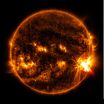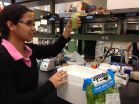(Press-News.org) OAK BROOK, Ill. – Adding tomosynthesis to biennial digital mammography screening for women with dense breasts is likely to improve breast cancer detection at a reasonable cost relative to biennial mammography screening alone, according to a new study published online in the journal Radiology.
Mammography remains the only screening test proven to decrease mortality from breast cancer. However, mammography is less accurate in women with dense breasts for whom cancers may be masked by overlapping breast tissue.
Moreover, dense breasts compared to average density breasts are associated with a moderate to high relative risk for developing breast cancer independent of the masking effect. Given that nearly half of the U.S. screening population has dense breasts, an increasingly large number of women may be encouraged to consider supplemental screening beyond conventional mammography.
"Screening MRI is the most sensitive breast imaging test, but is also more expensive, requires intravenous contrast injection and is currently reserved for screening women at high risk for breast cancer," said Christoph I. Lee, M.D., assistant professor in the Departments of Radiology Health Services at the University of Washington. "Digital breast tomosynthesis, in contrast to MRI, may offer operational and ease-of-use advantages since it is an integrated part of newer generation mammography units."
Digital breast tomosynthesis has shown promise at improving breast cancer detection in women with dense breast tissue. Tomosynthesis is similar to mammography in that it relies on ionizing radiation to generate images of the breast. However, unlike conventional mammography, tomosynthesis allows for three-dimensional (3-D) reconstruction of the breast tissue, which can then be viewed as sequential slices through the breast.
For this study, Dr. Lee and colleagues evaluated the comparative effectiveness of combined biennial digital mammography and tomosynthesis screening, compared to biennial digital mammography screening alone, among women with dense breasts.
The researchers used a breast cancer simulation model to estimate the comparative clinical effectiveness and cost-effectiveness of biennial screening with both digital mammography and tomosynthesis versus digital mammography alone among U.S. women ages 50 to74 years with dense breasts, using data and metrics from the National Cancer Institute's Breast Cancer Surveillance Consortium, Medicare reimbursement rates and medical literature.
"Our analysis, using currently available data, provides women, physicians, payers and policymakers in the U.S. with much needed information regarding the comparative effectiveness of combined mammography and tomosynthesis screening relative to mammography screening alone," Dr. Lee said.
Their analysis showed that the incremental cost per quality-adjusted life year (QALY) gained by adding tomosynthesis to digital mammography screening was $53,893. An additional 0.5 deaths were averted and 405 false-positives were avoided per 1,000 women after 12 rounds of screening. Combined screening remained cost-effective (less than $100,000 per QALY gained).
"The decrease in false-positive results after adding tomosynthesis is a major contributor to the cost-effectiveness of combined screening," Dr. Lee said. "Our study suggests that adding tomosynthesis at the time of mammography screening has the potential to decrease the number of unnecessary diagnostic work-ups and invasive procedures that result from false-positive findings."
INFORMATION:
"Comparative Effectiveness of Combined Digital Mammography and Tomosynthesis Screening for Women with Dense Breasts." Collaborating with Dr. Lee were Mucahit Cevik, M.S., Oguzhan Alagoz, Ph.D., Brian L. Sprague, Ph.D., Anna N.A. Tosteson, Sc.D., Diana L. Miglioretti, Ph.D., Karla Kerlikowske, M.D., Natasha K. Stout, Ph.D., Jeffrey G. Jarvik, M.D., M.P.H., Scott D. Ramsey, M.D., Ph.D., and Constance D. Lehman, MD, Ph.D.
This study was supported in part by the National Cancer Institute (NCI) and in part by a Radiology Research Academic Fellowship, co-sponsored by GE Healthcare (Waukesha, WI) and the Association of University Radiologists. The sponsors had no role in the study concept, study design, data analysis, interpretation, or reporting of the results. The authors had full control of the data and information submitted for publication.
Radiology is edited by Herbert Y. Kressel, M.D., Harvard Medical School, Boston, Mass., and owned and published by the Radiological Society of North America, Inc. (http://radiology.rsna.org/)
RSNA is an association of more than 53,000 radiologists, radiation oncologists, medical physicists and related scientists promoting excellence in patient care and health care delivery through education, research and technologic innovation. The Society is based in Oak Brook, Ill. (RSNA.org)
For patient-friendly information on breast cancer screening, visit RadiologyInfo.org.
Celebrate International Day of Radiology, November 8, 2014 – the 119th anniversary of the X-ray
The International Day of Radiology is building greater awareness of the value that radiology research, diagnosis and treatment contribute to safe patient care, and better understanding of the vital role radiologists perform in healthcare delivery. This year's theme is brain imaging. Visit IDOR 2014 to learn more.
http://www.internationaldayofradiology.com/
PISCATAWAY, NJ – Teenagers who live in communities with strict "social host" laws are less likely to spend their weekends drinking at parties, according to a study in the November issue of the Journal of Studies on Alcohol and Drugs.
Many U.S. states and local communities have passed social host laws, which hold adults responsible when underage drinkers imbibe on their property. The details of the laws vary, however, and research has been mixed as to whether they actually keep kids from drinking.
In the new study, investigators focused on 50 communities in California, ...
VANCOUVER ─ Robotically assisted coronary artery bypass grafting (CABG) surgery is a rapidly evolving technology that shortens hospital stays and reduces the need for blood products, while decreasing recovery times, making the procedure safer and less risky, says a study presented at the Canadian Cardiovascular Congress.
"Robotically assisted CABG is a safe and feasible alternative approach to standard bypass surgery in properly selected patients. It is a less traumatic and less invasive approach than regular CABG," says cardiac surgeon and researcher Dr. Richard ...
For the first time, researchers have found that exposure to radioactive iodine is associated with more aggressive forms of thyroid cancer, according to a careful study of nearly 12,000 people in Belarus who were exposed when they were children or adolescents to fallout from the 1986 Chernobyl nuclear power plant accident.
Researchers examined thyroid cancers diagnosed up to two decades after the Chernobyl accident and found that higher thyroid radiation doses estimated from measurements taken shortly after the accident were associated with more aggressive tumor features.
"Our ...
VANCOUVER ─ When heart symptoms strike, men and women go through similar stages of pain but women are more likely to delay seeking care and can put their health at risk, according to a study presented at the Canadian Cardiovascular Congress.
"The main danger is that when someone comes to the hospital with a more severe or advanced stage of heart disease, there are simply fewer treatment options available," says Dr. Catherine Kreatsoulas, lead author of the study and a Fulbright Scholar and Heart and Stroke Foundation Research Fellow at the Harvard School of Public ...
This news release is available in French. Compared to men who have had only one partner during their lifetime, having sex with more than 20 women is associated with a 28% lower risk of one day being diagnosed with prostate cancer, according to researchers at the University of Montreal and INRS - Institut Armand-Frappier. However, having more than 20 male partners in one's lifetime is associated with a twofold higher risk of getting prostate cancer compared to those who have never slept with a man.
Marie-Elise Parent and Marie-Claude Rousseau, professors at university's ...
PULLMAN, Wash. - Politicians who discredit global warming risk losing a big chunk of the female vote. A new study found women who consider the long-term consequences of their actions are more likely to adopt a liberal political orientation and take consumer and political steps to reduce global warming.
Jeff Joireman, associate professor of marketing at Washington State University, demonstrated that "future-oriented" women are the voting bloc most strongly motivated to invest money, time and taxes toward reducing global warming.
Previous studies have shown that women ...
Both agave nectar and a placebo were more effective than no treatment for young children's cough symptoms, according to researchers at Penn State College of Medicine. The findings suggest that a placebo could help children more than "watchful waiting."
The Food and Drug Administration recommends against the use of over-the-counter cough and cold medications in children under two years old due to safety concerns and a lack of evidence for their effectiveness in this age group. As part of a voluntary change announced in 2008 by the Consumer Healthcare Products Association, ...
Astronomers with the National Science Foundation (NSF)-funded National Optical Astronomy Observatory (NOAO) captured pictures not only of Thursday's partial solar eclipse, but also of the "monster" sized active region or sun spot that has many comparing it to one of a similar size that occurred 11 years ago.
The sun spots were earlier reported by scientists with the NSF-supported National Solar Observatory. According to astronomers Frank Hill and Kiran Jain, "As of Oct 21, 2014, a very large active region is currently on the solar disk and producing flares as strong as ...
A large active region on the sun erupted with another X-class flare on Oct. 27, 2014 -- its fourth since Oct. 24. The flare peaked at 10:47 a.m. EDT.
X-class denotes the most intense flares, while the number provides more information about its strength. An X2 is twice as intense as an X1, an X3 is three times as intense, etc.
To see how this event may affect Earth, please visit NOAA's Space Weather Prediction Center at http://spaceweather.gov, the U.S. government's official source for space weather forecasts, alerts, watches and warnings.
Continuing a week's worth ...
A world without plants would be a world without oxygen, uninhabitable for us and for many creatures. We know plants release oxygen by absorbing carbon dioxide and breaking down water using sunlight through the process of photosynthesis. However, we know little about the mechanics of how plants create oxygen during photosynthesis. A breakthrough that will help advance our understanding of this critical ecological process was made recently by scientists at LSU.
"Without photosynthesis or oxygen, basically all recognizable life that we see in our landscape would be gone: ...



